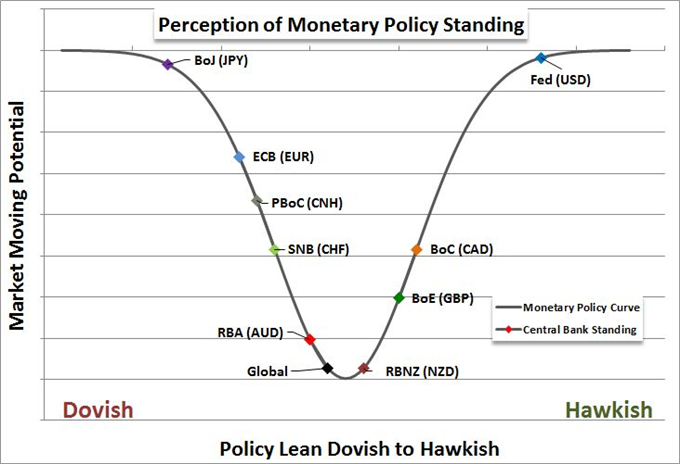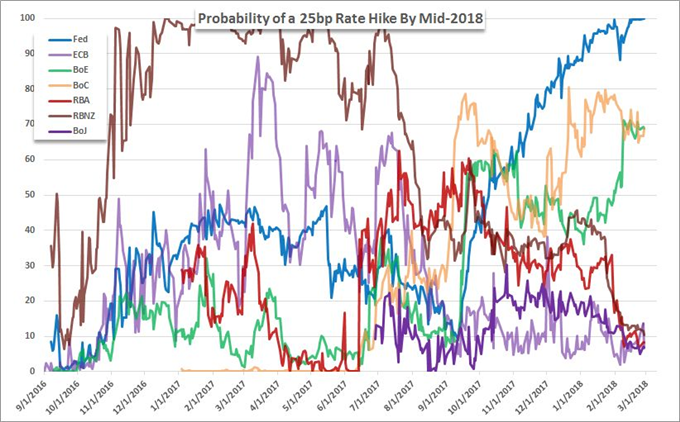Talking Points:
- There are four major central bank rate decisions due this week, watch both for relative FX impact and collective 'risk' influence
- The most important of the four is the ECB's decision where they are a key dove nearing the end of stimulus but fear the Euro
- A BoJ move is extremely unlikely but could extremely influential, the BoC is the number two hawk and the RBA is losing carry appeal
See how retail traders are positioning S&P 500, key global indices and other risk assets on an intraday basis using the DailyFX speculative positioning data on the sentiment page. Then, compare it to the longer-term speculative interest of futures traders in the COT report.
Monetary Policy: Relative FX Value, Aggregate Risk Trend Influence
Looking over the economic docket for the coming week, there an inordinate amount of key event risk on tap. The full round of updates will cover a range of themes from protectionism to political stability to economic health. Yet, among the various catalysts and under currents, the fundamental listing with the most consistent influence over the FX market over the past nine years has been monetary policy. As the major central banks implemented easing efforts with varying intensities and at different times, the drive of relative weakness saw currencies develop remarkable trends. The same is true when we slowly transitioned to tapering and general normalization from extreme easing. Yet, the opportunities found in relative monetary policy aren't the only influence this heavy charge has on the markets. Far too often overlooked is the aggregate influence that global policy has on risk trends. It is no coincidence that the most speculative markets have climbed in tandem with central bank balance sheets or inversely to the fall in benchmark yields. So, what happens as we progressively make our way to normalizing crisis-era policy?

The Most Pressing Central Bank Decision from a Trader's Perspective
There are four major central banks due to deliver their monetary policy decisions over the coming week. Economists and locals would select what they believed would be the most important of the group according to different criteria. As a trader, my filter is determining which is likely to have the greatest market impact. On that qualification alone, I would chose the European Central Bank's (ECB) decision on Thursday. While there may be some cross winds from US tariff fears, that is an issue the world will share. Otherwise, the other competing themes for the Euro's attention will be dormant or will have passed (like the political stability risk teased out by the Italian election). While the ECB is unlikely to change its policy mix, it is clearly troubled by the speculative interest driving their currency higher. It is likely that the level of EUR/USD has factored in on the group's reluctance to take more definitive steps towards policy normalization. ECB President Draghi and company has clearly taken issue with the height of the Euro and spun it into an issue with a possibly manipulated Dollar. This is a desperate bid to sway exchange rates with most of their ammo spent. They are unlikely to change active policy at this meeting, but keep a close eye on rhetoric.

The Bank of Japan Is Unlikely to Change Rates, But Remember Its Standings
Among the major central banks, the Bank of Japan's (BoJ) policies are the most dovish. Not that its rate is the lowest - the SNB and ECB baseline is negative. Nor is its QE effort the largest on all standards - though it is on a relative-to-GDP basis. But the Japanese authority has offered no indication of an eventual end to its aggressive accommodation. That is unprecedented. In turn, Japan's bearings represent a unique barometer for the global monetary policy balance and its influence on sentiment as previously accepted. It is the floor on the general range of central bank support for the capital markets. So, while the BoJ is unlikely to alter its language about policy moving forward, the impact on the global markets should they do so would be severe. Recognition that the 'punch bowl' is being removed represents one of the most definitive triggers for risk aversion that we have ahead of us.


BoC and RBA Keep Carry Currencies on Different Trajectories
The highest probability of a change in policy mix from the four decisions due this week rests with the Bank of Canada's (BoC) deliberation. Though the Canadian GDP reading for the fourth quarter this past Friday has cooled speculation that a hike is due at this meeting, this market still sees this group as the second most hawkish body next to the Fed. That being said, traders should not be too enthusiastic about what a hawkish rhetoric can afford the Canadian Dollar. For those keeping tabs on the currency, it has suffered dramatically over the past months as commodity supply pressures, NAFTA renegotiations and the new US tariff proposals most distinctly threaten Canada. Then there is the Reserve Bank of Australia's policy decision. Here too, no change is likely. However, inaction is a problem in itself. The Australian Dollar is a carry currency, yet carry globally is near a historic low and the Aussie benchmark rate will soon be overtaken by the US Dollar - the US being a large source of speculative capital. We discuss all of these rate decisions from the trader's perspective in this weekend Quick Take Video.

To receive John’s analysis directly via email, please SIGN UP HERE





